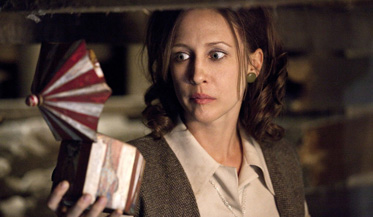Top Film Industry Stories of 2013: #11
Horror movies scare up big money
By Kim Hollis
January 6, 2014
This trend continued with the release of Warm Bodies, an amalgamation of romantic comedy and horror. Like Mama, it had a primarily female audience (60%) on opening weekend, which helped to drive the alt take on Romeo & Juliet to a $20.5 million opening. The end result for the well-regarded film was a $66.4 million domestic take, along with $50 million internationally. After a few years of seeing the zombie trope grow tired, Warm Bodies reinvigorated the sub-genre with an updated, fun mythology.
Also upping the ante on zombies and survivalism was World War Z, a movie that was looking as though it would be a financial disaster in the months leading up to the film’s release. Reports of reshoots and a troubled final act were rampant, but the changes proved to be sound, as the horror/action/thriller hybrid debuted with $66.4 million before going on to earn $202.4 million in North American venues. Add in $338 from overseas locations and Paramount actually wound up making money on a project that had a bloated $190 million budget. The film’s success can be credited to stellar marketing, which featured a fast-moving, zombie-inducing virus and some intricate set pieces, including a plane crash brought on by a cabin of suddenly infected passengers.
At the opposite end of the budget spectrum, but every bit as successful if looked at in scale, was The Purge, a tiny, $3 million-budgeted project that burst on the scene, surprising almost every box office analyst in the world with its $34.1 million opening. It was profitable within the first few hours of its release. A film that posits a future where the world is peaceful thanks to one night a year where all crime – any crime – is not only allowed, but encouraged, The Purge had a powerful final domestic box office total of $64.5 million. International revenues came in at just over $25 million.
The success of The Purge opened the door for 2013’s King of Horror, James Wan, to usher two similarly small-budgeted films into theaters. The first of these was the measured, deliberate The Conjuring, a haunted house story that stunned prognosticators as it debuted with a whopping $41.9 million over its first weekend. Like Mama and Warm Bodies before it, The Conjuring appealed to females, as the opening weekend audience was comprised of 53% women. Whereas most horror flicks have very little staying power at the box office (as you can tell by looking at almost all of the titles above), The Conjuring held on and on and on, finding an eventual domestic total of $137.4 million. Overseas, the film tallied another $180 million, meaning that this $20 million-budgeted project finished with a worldwide gross of almost $320 million. When people talk about big box office winners of 2013, The Conjuring probably doesn’t come up in conversation often, but it should. The money it brought in was almost pure profit.
Wan wasn’t satisfied by just delivering one whopping horror success, though. He followed up July’s The Conjuring a couple of months later with Insidious Chapter 2, a sequel to the 2011 film that earned a grand total $54 million in North America and $43 million overseas. Audiences were apparently keen to see the story continue, because Chapter 2 had a debut weekend of $40.3 million (compared to the first film’s $13.3 million opening). By the time it exited theaters, the sequel had earned $83.6 million domestically and $77 million internationally, meaning that Wan had two films in 2013 that exceeded $150 million in worldwide revenues. Costs were kept exceedingly low, as the budget was reported at just $5 million.
This boon year for horror can be attributed to a number of different factors, but the most notable commonality amongst the biggest successes is that all of them come from fresh, recent ideas. From zombie love stories to tales of ghosts to simple, straight-up haunted houses, audiences are responding to scary movies that give them something new and unique. Sure, the tried and true reboots/remakes and sequels to long-standing franchises may provide safe money as well, but we’re excited to see filmmakers finding inventive ways to scare us. We’re hopeful that the trend will continue, but based on past studio behavior, we’re guessing it’s much more likely that we see a slew of sequels to the films that succeeded.
Continued:
1
2




